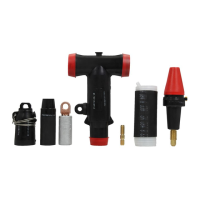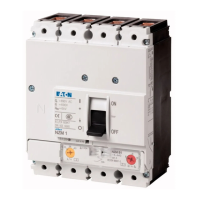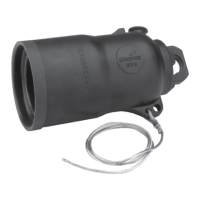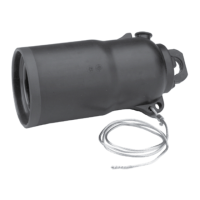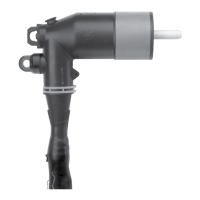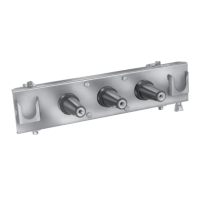Return the regulator to neutral
1. Use the Raise/Lower switch to bring the regulator to
the neutral position.
2. When in neutral, the Neutral Light will be continuously
lit on the control front panel and the position indicator
will point to zero.
3. Verify the neutral position of the regulator using four
methods.
A. Verify that the neutral indicator light on the control
is indicating the neutral position. Neutral is indicated
only when the light is continuously illuminated.
B. Verify the tap position of the control indicates neutral
(numeric key pad number 4).
C. Verify that the position indicator on the regulator is
in the neutral position.
D. Using an acceptable method, verify that there is
no voltage difference between the source and load
bushings.
4. When the regulator has been placed in the neutral
position, but prior to bypassing, additional safety action
must be taken to ensure that the tap-changer will not
inadvertently switch to an off-neutral position. This can
be accomplished by doing the following:
A. Place the CONTROL FUNCTION switch in the Off
position.
B. Remove the motor fuse.
C. Place the control POWER switch in the Off position.
D. Open V1, knife switch (and V6 if present) located on
the control back panel.
Removing the control
The control may be removed from the regulator with the
regulator energized. Record settings, etc., to facilitate
replacement of the control.
To open the control, unscrew the captive knob on the left
side of the panel. This allows the control to swing open on
its hinges. With the control open, the back panel is readily
accessible. The design of the control enclosure, back panel,
and control enables easy replacement of the control, leaving
the back panel, control enclosure, and cable intact. To
remove the control, proceed as follows:
1. Push closed the current shorting switch C. This shorts
out the secondary of the regulator CT.
Note: Regulators shipped with a quick-disconnect
cable contain a solid-state CT monitoring circuit
in the junction box. This device automatically
places a burden on the CT anytime the CT
circuit is opened. For consistency, it is recom-
mended that the CT shorting switch be used
whenever it is present on the back panel.
2. Pull open disconnect switch V1 (and V6 if present). This
de-energizes terminal board TB2.
3. Disconnect the control from the back panel at TB2,
located at the bottom of the back panel.
4. Disconnect the control ground lead from the back
panel.
The control can now be lifted off its hinges. Care should be
taken to prevent damage to a control while in transit and/or
storage.
WARNING
Explosion Hazard. To insure a complete tapping
operation when returning the tap changer to the neutral
position, the CONTROL FUNCTION switch must be
placed in the OFF position before the POWER switch is
placed in the OFF position. Failure to comply can result
in the tap changer stepping off of neutral immediately
upon being energized which can result in death or
severe personal injury and equipment damage.
WARNING
Explosion Hazard. After placing the regulator in the
neutral position for bypass switching, always disable
the motor to prevent a tap change during bypassing
which can result in the tap-changer stepping off of
neutral. Failure to comply can cause death or severe
personal injury and equipment damage.
WARNING
Flashover Hazard. Push the C shorting switch closed
before attempting to remove the front panel. Failure to
comply can open the regulator CT circuit, producing
a flashover in the control, causing personal injury and
equipment damage.
WARNING
Flashover Hazard. Do not pull open the current shorting
switch C until the TB2 connection is completed. Failure
to comply can open the regulator CT secondary and
cause a flashover in the control, causing personal injury
and equipment damage.
16
CL-6 SERIES CONTROL INSTALLATION, OPERATION, AND MAINTENANCE INSTRUCTIONS MN225016EN January 2016

